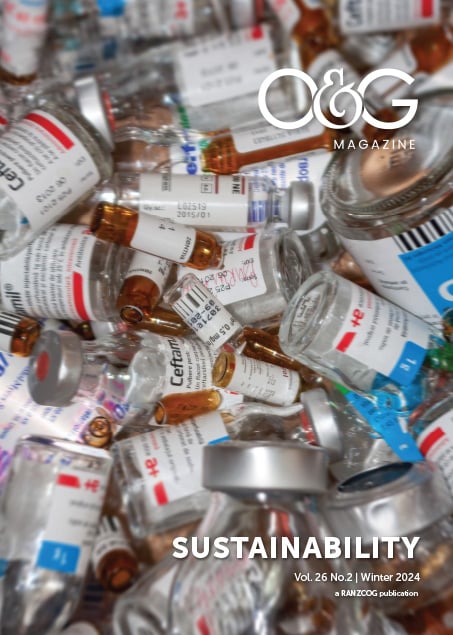Few of us would be completely untouched by the escalating climate and biodiversity crises. Human activities have raised the atmosphere’s carbon dioxide content by 50% in less than 200 years and the concentration of methane, a more powerful greenhouse gas, has more than doubled over that period1. Consequently, the earth’s average surface temperature is now the highest since written records began. Such heating drove the unprecedented fires of 2019-20, incinerating billions of animals and large swathes of landscapes, adversely impacting soils, forests, water and air quality. We then plunged into a global quarantine in response to the COVID-19 outbreak, followed, in 2022, by some of the worst flooding yet recorded.
Now, in 2024, the Great Barrier Reef is undergoing one of the worst bleaching events on record, threatening unique biodiversity, human wellbeing and livelihoods. As doctors our training equips us to keep patients within ‘safe’ physiological operating conditions to maintain health. Beyond individual biology, the social determinants of health such as income, education, and social inclusion, play crucial roles in both individuals and populations. Less commonly do we recognise the environmental determinants of health and the need to operate within ‘safe’ planetary resource boundaries. Yet the health of the biosphere is a ‘superdeterminant’ of all maternal and child health2.
The interlinked climate and biodiversity crises have common origins in our disregard for our collective responsibility to ‘care for country’, and their compounding adverse effects on human and planetary health. This challenge is being increasingly articulated by leading medical journals, governments and professional societies3. Indeed, our immediate response to this threat is a multidimensional ethical issue that will echo in the health of future generations4.
We recently explored the importance of such biodiversity-related ‘ecosystem services’ for human health and how these are deteriorating in Australia5. Beyond its classic role as sources of new medicines (‘provisioning’ benefits), healthcare is increasingly also recognising the therapeutic value of nature for physical and mental wellbeing (‘cultural’ benefits)6. The gut microbiome, a form of endemic human biodiversity, and the health effects of its depletion or dysbiosis, has previously been discussed in this magazine in an article written by Prof Peter Vuillermin Director of Research, Barwon Health Chair in Medicine, Deakin University titled ‘Microbial maternity: the importance of the gut microbiome in pregnancy’. The article examined how microbial exposures in the perinatal period may have lifelong and even transgenerational consequences. Similar themes are evident regarding the impacts of environmental pollutants7.
According to the World Health Organisation8, 24% of global deaths (and 28% of deaths among children under five) are due to modifiable environmental factors. It is estimated that environmental causes account for 6% (1–11%) of all adverse perinatal conditions in high-income countries, and for 11% (2–27%) in low-income countries. Widespread air, water and soil pollution, in part related to the chemical derivatives of fossil fuels, as well as from their combustion as fuels, are growing concerns for all of us, but especially for the most marginalised populations. Pregnant women and young children are acutely vulnerable to such toxicities — children have unique exposure pathways, and often experience higher exposures to pollutants. Their bodies may handle these exposures differently due to immature detoxification capacities, immune and thermoregulatory systems and are subject to critical windows of vulnerability.
For example, hydrocarbon combustion, via road traffic, coal and gas fuels, has adverse health and developmental impacts via both air pollution with gases (including sulphur and nitrogen oxides) and particle matter (PM), as well as, indirectly, through the climate impacts of greenhouse gas emissions7. This affects the physiology of the placenta and umbilical cord9. Breathing in PM and other pollutants may be compared to passive cigarette smoking. The health risk of living on a major freeway has been estimated as equivalent to ten passively smoked cigarettes daily10. A recent meta-analysis estimated a 22g lower birth weight (95% CI: 12–32), 11% higher risk of low birth weight (1.07–1.16) and a 12% higher risk of pre-term birth (1.06–1.19) each per 10 mg/m3 increase in ambient PM 2.5 9,11. Such toxicants can impair foetal and post-natal lung function and growth, promoting sensitisation of the airways leading to asthma and other respiratory illness and have also been linked to neurodevelopmental disorders7.
Hence, it is no exaggeration to say that children are existentially threatened by our current addiction to fossil fuel use8. Closing coal-fired power plants is a positive development, but replacing these with gas is not the answer. Indeed, “natural” gas is no more natural than other hydrocarbons and is neither “clean” nor healthy. Beyond further greenhouse gas emissions, unconventional gas development poses health risks from pollutants in air and water. Moreover, chemicals used or generated in the fracking process are potentially damaging to the foetus and young children. This includes higher risks of low birth weight, pre-term birth, some types of congenital malformation such as heart defects and increased risks of asthma exacerbations12.
Beyond the direct toxicity of such fuels, additional, and compounding risks arise from extreme weather event driven water and food insecurity, heat stress, emerging infectious diseases, mental ill-health and population displacement with concomitant disruption of healthcare access. As discussed elsewhere in this issue, climate change is also driving unprecedented bushfire events and associated respiratory and pregnancy complications. Extreme heat events are increasing in frequency and severity as climate change worsens. Pregnant women are particularly vulnerable as extreme ambient heat can contribute to a range of adverse outcomes including pre-term and stillbirth, low birth weight, and congenital anomalies13.
Increasing temperature, rising sea levels and flooding are transforming the patterns and geographical extent of vector-borne diseases14. Complex interactions between vectors, reservoir hosts, human behaviours and pathogens may promote or inhibit such diseases. In Australia, we have already seen the unprecedented outbreak of Japanese encephalitis, resulting from a flavivirus infection spread by Culex mosquitoes, that followed the 2021-2022 flooding in the Murray-Darling Basin — the potential for endemic transmission is now considered ‘likely’15.
Another concerning aspect of the degradation of our natural environment is the now ubiquitous chemical pollution. Microplastics and endocrine disrupting chemicals are key areas where our knowledge is still limited. It is estimated that 79% of all plastic waste produced ends up in landfill, or elsewhere in the environment, while 12% is incinerated and only 9% recycled16. Microplastics in the environment (plastic particles smaller than 5mm) degrade, generating potentially toxic modified products, and they can also act as carriers for a diverse group of chemicals17. They have been found in food and drinking water, and recently in the human placenta and breast milk, leading to concerns that they may engender adverse pregnancy outcomes.
Small changes in hormonal balance can have important effects on both the mother and the developing foetus18. Endocrine-disrupting chemicals (EDCs) are a group of exogenous chemicals that may alter hormonal and homeostatic systems. Heterogeneous in nature, they include industrial solvents and their by-products, plastics, plasticisers, pesticides and more. Many chemicals used during gas extraction processes are EDCs, as are flame retardants, and Bisphenol A (BPA) used in manufacturing, food packaging, and previously, in baby feeding bottles. Studies to date suggest that EDCs affect prenatal growth, thyroid function, glucose metabolism, obesity, puberty, and fertility19.
It’s time to recognise how connected to the natural environment and the web of life we are, and how, despite the existential threats implied by these problems, there is a way forward. We can get our healthcare house in order and become part of the solution rather the problem. We can prepare future doctors for these threats through education. We can advocate for legislative protections for our native species and the environment, and for the expansion of renewable energy. We can join groups with similar goals. The International Federation of Gynaecology and Obstetrics (FIGO), and the Asia and Oceania Federations (AOFOG) have climate change and pollution committees working to reduce healthcare waste and pollution20.
Indeed, 50 years ago, such an advocate was our Federal Minister for the Environment and Conservation: the late Dr Moss Cass, a Melbourne University medical graduate, who was responsible for the most important of all post-war environmental legislation. His summarised ethos was: “We have not inherited this earth from our parents to do with it what we will. We have borrowed it from our children, and we must be careful to use it in their interests as well as our own”21.
Associate Professor Kenneth D Winkel, Melbourne School of Population and Global Health, University of Melbourne and Adjunct Associate Professor Marion Carey, School of Medicine, University of Notre Dame Australia, Sydney, NSW.
References
- Climate change. NASA science.nasa.gov/climate-change/ accessed 24 April 2024.
- Souza JP, Day LT, Rezende-Gomes AC, et al. Maternal Health in the Perinatal Period and Beyond. A global analysis of the determinants of maternal health and transitions in maternal mortality. Lancet Glob Health 2024;12(2):e306-e316.
- Abbasi K, Ali P, Barbour V, et al. Time to treat the climate and nature crisis as one indivisible global health emergency. Med J Aust 2023;219(11):530-532.
- Williams PCM, Beardsley J, Isaacs D, et al. The impact of climate change and biodiversity loss on the health of children: An ethical perspective. Front Public Health 2023;10:1048317.
- Barraclough KA, Carey M, Winkel KD, et al. Why losing Australia’s biodiversity matters for human health: insights from the latest State of the Environment assessment. Med J Aust. 2023;218(8):336-340.
- Nguyen PY, Astell-Burt T, Rahimi-Ardabili H, Feng X. Effect of nature prescriptions on cardiometabolic and mental health, and physical activity: a systematic review. Lancet Planet Health. 2023;7(4):e313-e328.
- Perera F, Nadeau K. Climate change, fossil-fuel pollution and children’s health. N Engl J Med 2022;386(24):2303-2314.
- Prüss-Üstün A, Wolf J, Corvalán C, Bos R, Neira M. Preventing disease through healthy environments: a global assessment of the burden of disease from environmental risks. World Health Organisation 2016. Available at iris.who.int/handle/10665/204585
- Ghosh R, Causey K, Burkart K, Wozniak S, et al. Ambient and household PM2.5 pollution and adverse perinatal outcomes: A meta-regression and analysis of attributable global burden for 204 countries and territories. PLoS Med 2021;18(9):e1003718.
- Van der Zee SC, Fischer PH, Hoek G. Air pollution in perspective: Health risks of air pollution expressed in equivalent numbers of passively smoked cigarettes. Environ Res. 2016;148:475-483.
- Fussell JC, Jauniaux E, Smith RB, Burton GJ. Ambient air pollution and adverse birth outcomes: A review of underlying mechanisms. BJOG. 2024;131(5):538-550.
- Deziel NC, Brokovich E, Grotto I, Clark CJ, et al. Unconventional oil and gas development and health outcomes: A scoping review of the epidemiological research. Environ Res. 2020;182:109124.
- Meltzer GY, Factor-Litvak P, Herbstman JB, et al. Indoor temperature and energy insecurity: implications for prenatal health disparities in extreme heat events. Env Health Perspect 2024;132(3):35001.
- Thomson MC, Stanberry LR. Climate Change and Vector borne Diseases. N Engl J Med 2022;387(21):1969-1978.
- McGuinness SL, Lau CL, Leder K. Co-circulation of Murray Valley encephalitis virus and Japanese encephalitis virus in south-eastern Australia. J Travel Med. 2023;30(7):taad059.
- United Nations. 2021. In images: Plastic is forever. un.org/en/exhibits/exhibit/in-images-plastic-forever accessed 24 April 2024.
- Sripada K, Wierzbicka A, Abass K, et al. A Children’s Health Perspective on Nano- and Microplastics. Environ Health Perspect. 2022;130(1):15001.
- Plante I, Winn LM, Vaillancourt C, Grigorova P, Parent L. Killing two birds with one stone: Pregnancy is a sensitive window for endocrine effects on both the mother and the fetus. Environ Res. 2022;205:112435.
- Predieri B, Lughetti L, Bernasconi S, Street ME. Endocrine Disrupting Chemicals’ Effects in Children: What We Know and What We Need to Learn? Int J Mol Sci. 2022;23(19):11899.
- Gupta K. Impact of Climate Change, Environmental Toxins and Pollution on the AOFOG region: What can OBGYNs do? J Obstet Gynaecol India. 2024;74(1):22-26.
- Dreyfus, M. Remembering Moses (Moss) Henry Cass. 6 June 2022. Speech available at: ministers.ag.gov.au/media-centre/speeches/remembering-moses-moss-henry-cass-06-06-2022







Amazing information